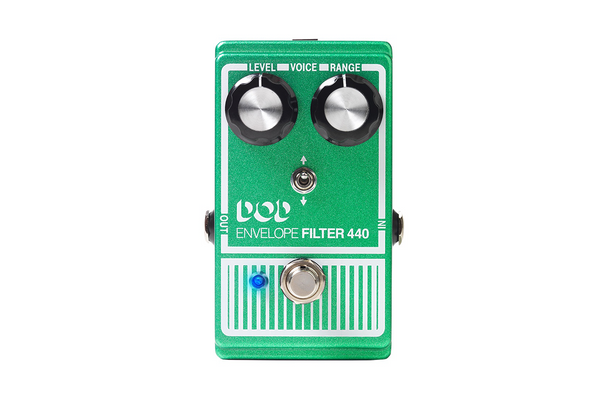I’m of the mind that a good envelope filter should be simple and sound distinct. I also think there’s a fine line between an envelope filter that sounds good and one that’s too much. And when I plug one in, I don’t want to spend too much time twiddling. While I realize that sounds like an awfully particular set of personal preferences, they seem to be pretty common ones.
The DOD Envelope Filter 440, however, hits the sweet spot for me. It’s simple enough to plug and play. I can easily find the sounds I want and dial them in with accuracy. Better yet, the DOD 440 has its own personality—a distinct warm voice that sets it apart from the competition—as well a long history behind it.
What’s Old Is New
The Envelope Filter 440 was first introduced in the ’70s, and you may have heard that unit on the pedalboards of sonic pioneers like Jonny Greenwood or Steven Drozd. It was reissued by DOD back in 2014, before the company’s temporary demise. But now that they’re back, so is the 440.
While the 440’s colors have changed occasionally, this pedal has always had a simple, retro look to it. That aesthetic is in line with the pedal’s utilitarian controls. The original version’s knobs for sensitivity and range are duplicated here (though the sensitivity control is called level, it performs the same function). With such simple features, any addition is dramatic, and the reissue includes a voice switch, not found on the ’70s iteration, that reverses the direction of the filter—a welcome and crucial addition.
Fun Funk
There’s something inherently fun about envelope filters, and the DOD is no exception. It’s a responsive unit with a wide range of sensitivity, so I was able to find the sound I wanted as I switched around on different guitars. And the range of the two knobs led me to some great sounds.
The sweep of the 440’s filter can be smooth and fairly quick. It’s fast enough to reward high-energy melodic playing, where a note’s attack gets an assist from the filter. But it’s not so quick that you don’t hear the sweep, and a big part of the fun is finding the settings where that sweep can be coaxed for dramatic effect. Using the 440 in combination with overdrive and delay amplifies that sweep into a synth-y goo, a great reminder that envelope filters are great, not just for funk jams and Jerry-heads, but also for cathartic noisy adventures.
The switchable voice direction elevates the 440 from a super-basic two-knob unit to a still-basic pedal with twice as much functionality. It’s a cool, useful feature that lots of envelope filter tourists, myself included, would love to have without going all-in on something more option-heavy like a Mu-Tron, fantastic as those might be. I loved contrasting the light-to-dark/dark-to-light voices and finding inspiring tones that kept me writing riffs and layering my sounds.
The Verdict
Simplicity is a key for a lot of envelope filter users. The 440 absolutely nails simple, sticking closely to the original’s user experience and adding one really cool control in the voice switch. In both settings, the 440 delivers a warm, responsive tone with a just-right filter sensitivity that will scratch the itch for most players. Other brands offer more features to varying degrees at a similar, reasonable price. But if simplicity is key, the DOD still sounds great right out of the box. PG




















